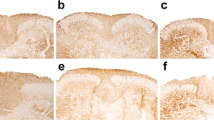Morphological and morphometric studies of the dorsal roots of spinal nerves (segment SI) were studied in nine mongrel dogs aged 2, 5, and 10 months. Longitudinal paraffin sections impregnated with silver nitrate were used, along with semithin transverse sections stained with methylene blue and basic fuchsin. Common features were seen in the structural organization and the characteristics of nerve fiber dispositions at these ages. Increasing age was associated with enlargement of the dorsal roots (most marked before five months), along with increases in the diameter and changes in the ratios of small, intermediate, and large myelinated nerve fibers and decreases in their numbers per unit area.
Similar content being viewed by others
References
S. Glants, Medical-Biological Statistics [in Russian], Praktika, Moscow (1998).
O. N. Dreval, G. N. Krivitskaya, and O. V. Akatov, “Morphological basis of the pathogenetic conditions for pain-relieving operations in the area of the input zones of the dorsal roots,” Vopr. Neirokhir., No. 4, 22–25 (1996).
L. I. Kolosova, A. D. Nozdrachev, A. B. Moiseeva, et al., “Recovery of mechanoreception at the initial stage of regeneration of damaged rat sciatic nerve in conditions of central axotomy of sensory neurons,” Ros. Fiziol. Zh., 89, No. 5, 579–584 (2003).
E. I. Kravchuk, “Quantitative analysis of neurocytes in the lumbar spinal ganglia in humans during the second half of intrauterine life,” Morf. Vedomosti, No. 1–2, Suppl. No. 1, 144–145 (2006).
P. M. Maslyukov, M. M. Fateev, and V. V. Shilkin, “Asymmetry of the neuronal organization of the stellate (cervicothoracic) ganglion in cats during postnatal ontogeny,” Morfologiya, 115, No. 3, 65–67 (1999).
A. I. Sergeev,V. M. Kalinichenko, and L. A. Smirnova, “Development of the vertebral column, spinal cord, and spinal nerve roots in human fetuses,” Morfologiya, 131, No. 2, 121 (2008).
Yu. A. Chelyshev, I. S. Raginov, D. S. Guseva, and R. F. Masgutov, “Survival and phenotypic characteristics of axotomized neurons in the spinal ganglia,” Morfologiya, 125, No. 3, 45–49 (2004).
C. Darian-Smith, “Primary afferent terminal sprouting after a cervical dorsal rootlet section in the macaque monkey,” J. Comp. Neurol., 470, No. 2, 134–150 (2004).
Q. Ma, “Vanilloid receptor homologue, VRL1, is expressed by both A- and C-fiber sensory neurons,” Neuroreport, 12, No. 17, 3693–3695 (2001).
M. Ramer, J. Priestley, and S. McMahon, “Functional regeneration of sensory axons into adult spinal cord,” Nature, 403, 312–316 (2000).
Author information
Authors and Affiliations
Corresponding author
Additional information
Translated from Morfologiya, Vol. 139, No. 2, pp. 36–40, March–April, 2011.
Rights and permissions
About this article
Cite this article
Safonova, G.D., Panasenko, S.V. Dynamics of Structural Rearrangements in the Dorsal Roots of Spinal Nerves in Growing Dogs. Neurosci Behav Physi 42, 612–616 (2012). https://doi.org/10.1007/s11055-012-9610-2
Received:
Revised:
Published:
Issue Date:
DOI: https://doi.org/10.1007/s11055-012-9610-2



